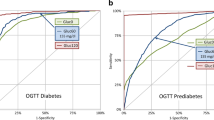Abstract
Objective:
To determine whether a threshold of a 1-h glucose challenge test (GCT) eliminates the need for a 3-h glucose tolerance test (GTT).
Study Design:
A retrospective cohort of patients undergoing GTT after GCT was ⩾140 mg dl−1. Gestational diabetes mellitus (GDM) was diagnosed using National Diabetes Data Group (NDDG) and Carpenter–Coustan (CC) criteria. Sensitivity, specificity and predictive values were calculated for 1-h GCT values of 160 to 220 mg dl−1.
Result:
Of 6218 patients, 988 (15.9%) had an elevated GCT and 753 (12.1%) underwent a GTT. In all, 165 (2.7%) were diagnosed with GDM using NDDG criteria, and 250 (4.0%) by CC criteria. The positive predictive value of a 1-h of GCT ⩾200 mg dl−1 for GDM was 68.6% by NDDG and 80.0% for GDM by CC criteria.
Conclusion:
Although the predictive value of an elevated 1-h ⩽200 mg dl−1 for GDM was high, 1 in 3 to 1 in 5 women would be overdiagnosed with GDM if the 3-h GTT was omitted.
This is a preview of subscription content, access via your institution
Access options
Subscribe to this journal
Receive 12 print issues and online access
$259.00 per year
only $21.58 per issue
Buy this article
- Purchase on Springer Link
- Instant access to full article PDF
Prices may be subject to local taxes which are calculated during checkout



Similar content being viewed by others
References
Committee on Practice Bulletins—Obstetrics. Practice Bulletin No. 137: Gestational diabetes mellitus. Obstet Gynecol 2013; 122 (2 Pt 1): 406–416.
Carpenter MW, Coustan DR . Criteria for screening tests for gestational diabetes. Am J Obstet Gynecol 1982; 144 (7): 768–773.
Yogev Y, Langer O, Xenakis EM, Rosenn B . Glucose screening in Mexican-American women. Obstet Gynecol 2004; 103 (6): 1241–1245.
Friedman S, Khoury-Collado F, Dalloul M, Sherer DM, Abulafia O . Glucose challenge test threshold values in screening for gestational diabetes among black women. Am J Obstet Gynecol 2006; 194 (5): e46–e48.
Cheng YW, Esakoff TF, Block-Kurbisch I, Ustinov A, Shafer S, Caughey AB . Screening or diagnostic: markedly elevated glucose loading test and perinatal outcomes. J Matern Fetal Neonatal Med 2006; 19 (11): 729–734.
Bobrowski RA, Bottoms SF, Micallef JA, Dombrowski MP . Is the 50-gram glucose screening test ever diagnostic? J Matern Fetal Med 1996; 5 (6): 317–320.
Landy HJ, Gómez-Marín O, O'Sullivan MJ . Diagnosing gestational diabetes mellitus: use of a glucose screen without administering the glucose tolerance test. Obstet Gynecol 1996; 87 (3): 395–400.
Shivvers SA, Lucas MJ . Gestational diabetes Is a 50-g screening result>or=200mg/dL diagnostic? J Reprod Med 1999; 44 (8): 685–688.
Lanni S, Barrett D . The predictive value of the 1-h 50-g glucose screen for diagnosing gestational diabetes mellitus in a high-risk population. J Matern Fetal Neonatal Med 2004; 15 (6): 375–379.
Ruopp MD, Perkins NJ, Whitcomb BW, Schisterman EF . Youden Index and optimalcut-point estimated from observations affected by a lower limit of detection. Biomed J 2008; 50 (3): 419–430.
Ferrara A, Hedderson MM, Quesenberry CP, Selby JV . Prevalence of gestational diabetes mellitus detected by the national diabetes data group or the carpenter and coustan plasma glucose thresholds. Diabetes Care 2002; 25 (9): 1625–1630.
HAPO Study Cooperative Research Group, Metzger BE, Lowe LP, Dyer AR, Trimble ER, Chaovarindr U, Coustan DR et al. Hyperglycemia and adverse pregnancy outcomes. N Engl J Med 2008; 358 (19): 1991–2002.
Acknowledgements
Dr Cahill was a Robert Wood Johnson Foundation Faculty Physician Scholar who partially supported this work. Dr Temming is supported by an NIH T32 training grant (5T32HD055172-07). This publication was also made possible by Grant Number UL1 TR000448 from the NIH National Center for Advancing Translational Sciences (NCATS), components of the National Institutes of Health (NIH), and NIH Roadmap for Medical Research. Its contents are solely the responsibility of the authors and do not necessarily represent the official view of NCATS or NIH. Presented as Poster #354 at the 36th Annual Meeting of the Society of Maternal and Fetal Medicine, 5 to 7 February 2015, San Diego, CA, USA.
Author information
Authors and Affiliations
Corresponding author
Ethics declarations
Competing interests
The authors declare no conflict of interest.
Rights and permissions
About this article
Cite this article
Temming, L., Tuuli, M., Stout, M. et al. Diagnostic ability of elevated 1-h glucose challenge test. J Perinatol 36, 342–346 (2016). https://doi.org/10.1038/jp.2015.215
Received:
Revised:
Accepted:
Published:
Issue Date:
DOI: https://doi.org/10.1038/jp.2015.215



